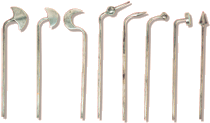


The cautery

|
Set of eight cauteries: Steel; 18th and 19th centuries; 27,2x0,8x6cm / 27,3x0,8x5,5cm / 27x1,5x5,8cm - 27,5x2,3x5,3cm / 26,8x3,2x4,5cm / 29x2,8x7,7cm / 27,7x0,9x5,7cm / 2x2x27,5cm |
Because of its capacity to conduct the heat, metals could be used to transmit heat to the tissues. In the production of cauteries gold, copper, silver, lead, iron, steel and platinum were used. Because of its characteristics each metal had its own supporters: gold and silver gave the heat away quickly; copper, iron, steel and platinum, because of their change in color, were a good thermometric sign; platinum had all the advantages but its high cost limited its use. Steel met all the requirements and was preferentially used to manufacture cauteries. Yet, ancient surgeons thought differently: Avicena preferred gold and Albucasis preferred iron since this metal allowed quantifying of the temperature achieved, it cooled slowly and, unlike gold, would not melt in case of excessive heating. However, the first metal used has been bronze, used by the Amazonas as a cautery, as quoted by Hipocratis, but it has soon been abandoned because of its excessive ductility.
The instrument consists of an actual cautery, a cylindrical shaft, and a wooden isolating handle, common to other cauteries. In Fig. - we can see seven actual cauteries and their respective cylindrical shafts. The wooden handle, maybe due to its organic nature, may have been the target to degrading and disintegrating with time, which most probably explains its absence. The names of the cauteries depended on the adopted shape: cane shaped, cylindrical, olive shaped, conical (Celso), plane nummular, ring shaped and cutlass shaped, among the most important. The olive shape seems to have been the most used and has been described first by Paulo de Engina (625 - 690). The Arabes had a rich diversity in the shape of their cauteries. They were used as a therapy for a vast number of organic as well as functional affections, limited only by each patient personality. However, throughout the years, the surgeon had to adapt himself to the use of the same cautery to achieve different goals, due to the lack of variety in the shapes of the instruments available.
The temperature achieved was very important in the mechanism of action and the color of the steel or iron could give such information: the gray, the dark red, the cherry red, the yellowish red and the whitish red, following an ascending scale of intensity. The pain elicited was inversely proportional to the temperature of the cautery. High temperatures would section the blood vessels while lower temperatures would coagulate them. Such cauterization was called inherent - sustained contact of the cautery with the soft tissues - and it is the only with haemostatic interest.
However, metals were not the only agents of actual cauterization used in Surgery. Water, in his two physical forms (Albucasis), solar rays, incandescent wood and lightning gas flame (Nelaton) were also used.
The 17th century Portuguese surgeons still preferred the cauterization for the treatment of a variety of pathologies and for hæmostasis while in the next century a progressive abandon of this practice was seen.
The actual cautery would have substitutes in the 19th century.
Electricity was extensively used in Surgery after the year of 1850. In 1854 Albrecht Theodore von Middledorpf (1824 - 1868), physicist in Breslau, Germany, publishes "Die Galvanocautik" were he describes the surgical use of electricity. A thin platinum wire, connected through an isolating needle to a galvanic battery, forms the galvano-cautery of Middledorpf. Due to a smaller local bleeding and to a lesser injury to the patient, supporters rapidly appeared. However, technological limitations in the production of the galvanic battery restricted its use. As a matter of fact, not only was it expensive but it also had the actual cautery known drawbacks: large areas of action destroyed, peripheral vessels bleeding and hard healing. Several instrument manufacturers in Europe and America have dedicated to producing different electrode models. The galvanic current of high intensity and low tension - galvanopuncture - elicited intense caloric effect that was necessary to blood clotting, with no scar formation. The present electrical coagulator has a device that allows for regulation of the general alternating current tension and another one that converts it to direct current. It is, then, the return to the principle of the primitive Middledorpf's galvano-cautery.
In 1875, Dr. Paquelin created the thermal cautery, later improved in 1891. It is based on the characteristic of platinum to heat condensing certain gases and vapors especially volatile carbides from mineral essence. It is formed by the cautery, the carbide container - a recipient to the essence that must weigh 710 g/liter at the temperature of 15º C - and a bellows formed by two rubber pears connected through rubber tubes. The combustion without flame of the air rich in carbide made the platinum cautery incandescent in a way proportional to the gas flow. Hæmostasis was one of its multiple uses.